In 1977, Laurance Rockefeller separated the “Premises”, the land that Caneel Bay Plantation sat on, from the “Improvements”, the structures and operation of the resort. 150 acres of the “Premises” were deeded to the Rockefeller family land trust, Jackson Hole Preserve, Inc. (JHPI); the structures or “Improvements” on that land were kept by Caneel Bay, Inc. with a future Deed that would revert the “Improvements” to Jackson Hole Preserve on September 30th, 2023
In 1983, Jackson Hole Preserve donated the land “Premises” to the National Park Service (NPS) for inclusion in the Virgin Islands National Park through a legal document called the 1983 Indenture. Not included were the “Improvements” or structures that were still held by Caneel Bay, Inc. The Indenture granted JHPI the exclusive right to use and occupy the “Premises” for 40 years through a unique arrangement that set aside the resort for independent operation and management without rent payments as it would expire on September 30, 2023, when the resort would be transferred to NPS. This “Retained Use Estate” (RUE) had certain rights and conditions including, but not limited to:
TERM: The term of the RUE would continue for a period of 40 years, ending on September 30, 2023 in order to carry out Grantor’s longstanding objective that the “Premise” ultimately be an integral part of the Virgin Islands National Park under the jurisdiction of the Secretary (US Dept of Interior) for the use and enjoyment to visitors to the Park….
MAINTENANCE: Grantor agrees that at ALL {emphasis added} times prior to the termination of the Retained Use Estate pursuant to paragraph 8 below Grantor will use and maintain the Premises in such a manner that will (a) be consistent with the preservation of such outstanding scenic and other features of national significance and (b) preserve the Premises to the extent feasible in their natural condition for the public benefit, enjoyment and inspiration subject, however, to right of Grantor to operate guest facilities for the accommodation of visitors to the Park…
[Some local environmentalists contend that CBIA has forfeited its right to maintain control of the property because CBIA has violated the RUE– not only because of the property’s current derelict condition, but also because public access to most of the property has been denied since the hurricanes ]https://stthomassource.com/content/2019/06/06/cbia-seeks-to-terminate-lease-for-caneel-bay-resort/#:~:text=Some%20local%20environmentalists%20contend%20that,been%20denied%20since%20the%20hurricanes.
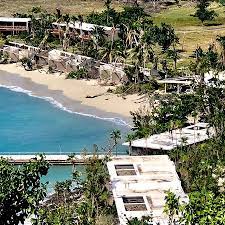
Termination by Grantor of the Retained Use Estate: This is Section 8 of the Indenture that EHI is trying to use to quiet claim the ownership of all land, buildings, facilities of the ‘Premises’ and their “Improvements”. Assistant US Attorney Hewitt has stated in her Motion to Dismiss that conveyance and transfer under this Section was meant to be by gift. According to Ani Kame’enui, the legislative director for the National Parks Conservation Association, Gary Engle exaggerated his interpretation of that document by putting conditions on how he could walk away from it. “In the 1983 (RUE) paperwork, there is a reversion clause. But that reversion clause is not conditional …..So if he wanted to fully convey and transfer to DOI (Department Of Interior) and just be done, he could. But he can’t do that with conditions” https://www.nationalparkstraveler.org/2022/06/operator-caneel-bay-resort-claims-ownership-sues-united-states.
Furthermore, the warranty deed stipulates that when the Retained Use Estate terminates, the owner of the lease must donate all of the buildings and other improvements to the NPS, including any additions added during the term of the RUE.
The resort changed hands several times causing Mr. Rockefeller such concern that he wrote to the Park Service director in 1988:
“I am concerned that the Park Service may be asked to extend the term of the Retained Use Estate, which would have the effect of enriching the seller and defeating the foundation’s intent to add the Caneel property to the park as scheduled,” wrote Rockefeller. “Caneel Bay is a very special site of outstanding scenic beauty which we believe should be protected and made available to the public as part of Virgin Islands National Park. We have been working together with the Park Service for over thirty years to achieve this end, but ultimately, your successors will determine whether and when the public will have the opportunity to enjoy the site as we intended.”
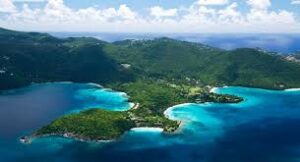
In 2004, Deutsche Bank sold its rights to the “Retained Use Estate” to CBI Acquisitions giving the company only the right to operate the resort facilities. CBIA entered into a contract with Rosewood Hotel Group to have them continue managing the day-to-day operations until 2013 when Rosewood chose not to renew its contract. I was unable to find any document that conveyed title to the structures or “Improvements” to CBI Acquisitions or any of its affiliates.
A law was passed in 2010 allowing the NPS to begin lease negotiations with the CBI Acquisitions in order to transition from the “Retained Use Estate” to a more comprehensive concession arrangement at which time a lengthy environmental assessment was undertaken by the Park. The recommendation of that report was a 40-year non-competitive lease agreement. While it is not typical for long-term leases of public land to be arranged without competitive bidding, the park service argued that Caneel Bay is an exceptional case. NPS does not have the authority to enter into a noncompetitive lease under existing regulations (36 CFR §18, Leasing of Properties in Park Areas). However, those negotiations were fruitless as CBIA refused the offer seeking more leverage for profit.
https://stjohnsource.com/2018/04/03/plasketts-caneel-bay-resort-bill-sparks-community-questions/
After the devastation of storms of Irma and Maria in 2017, CBI Acquisitions lobbied for an 60-year extension continuation of the “RUE”, but that bill never made it past Congress. The NPS continued its attempt to negotiate a concession agreement from September 30, 2023 onward with CBIA. However, CBIA still would not entertain a leasing agreement with the National Park Service.
On April 30, 2019, CBIA made its $70 million request to Interior Secretary Bernhardt for the sale of its remaining rights to the RUE. In this letter, Gary Engle reminded the DOI that CBIA owns the marina at Caneel Bay and the company may not grant access to another operator should the offer of purchase be declined. https://www.nationalparkstraveler.org/sites/default/files/attachments/gary_engle_letter_2019.pdf
On May 16, 2019, the business entity EHI Acquisitions LLC (553398) was established on St Thomas as a subsidiary of CBI Acquisitions with Gary Engle as President.
A letter from DOI (the Interior Department) to CBIA, dated Oct. 10, 2019, outlined several options for Mr. Engle’s consideration, including options if EHI/CBIA wishes to conclude or continue the operation of the Caneel Bay Resort,” stating that.”The specific terms proposed by CBIA, including payment of $70 million, do not constitute a valid offer to terminate the Retained Use Estate. “https://www.nationalparkstraveler.org/2019/12/updated-paradise-lost-virgin-islands-national-park#comment-89184
On June 20, 2022 the USVI Economical Development Commission Tax Incentive Program (EDC) revoked the CBIA/EHI tax benefit certificate.
On June 30, 2022 EHI Acquisitions, LLC, filed a civil lawsuit against the Federal Government in the U.S.V.I. District Court, requesting that exclusive ownership of 170 acre “Premises” be awarded to the company through quiet title. It included all land, docks, structures and “Improvements” and “Premises” based on their interpretation of Section 8 of the 1983 Indenture. EHI claims that because the Secretary of the Department of Interior refused CBIA’s buyout offer of $70M, that the reverter clause grants them full ownership in opposition to the Secretary of the Department of Interiors letter dated Oct 10, 2019. Interestingly, CBI Acquisitions is not even named as a party to the claim, only EHI Acquisitions which, from what I could find, was only created in 2019 as a subsidiary of CBIA with Gary Engle as President. EHI is also asking the court for reimbursement of legal fees and associated costs paid out to adjudicate the civil action.
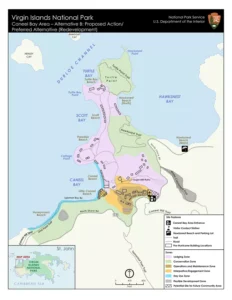
On July 28, 2023 the Virgin Islands National Park completed its Caneel Bay Redevelopment and Management Environmental Assessment (EA), outlining plans to restore commercial overnight accommodations at Caneel Bay and continue a long legacy of hospitality and conservation. Determinations are outlined in a decision document called a Finding of No Significant Impact (FONSI) and signed by National Park Service (NPS) Southeast Regional Director Mark Foust. https://parkplanning.nps.gov/document.cfm?parkID=412&projectID=101399&documentID=130684.
It is undisclosed whether the NPS is still negotiating with CBIA for this concession agreement. When I asked the previous Superintendent of Virgin Islands National Park, Nigel Fields, at a local Rotary Club meeting whether CBIA would continue to be considered for the concession, he stated that negotiations were closed and not public. Mr. Fields also added that the term could be for a period of up to 60 years depending on the amount of investment the concessionaire would add to any offering.
On September 6, 2023 Assistant V.I. attorney Jocelyn Hewlett filed a separate motion, asking the court to schedule a hearing on the government’s motion to dismiss EHI’s complaint, and both parties’ motions for summary judgment. She also asked the court to stay all deadlines pending ruling on the outstanding motions.
On September 28, 2023 Chief District Court Judge Robert Molloy granted the United States’ motion to stay the trial concerning the September 30, 2023, expiration of the Caneel Bay Resort Retained Use Estate (RUE) as the court moves to resolve the case.
Both parties have pending Motions for Summary Judgment that have been fully briefed. This case hinges on the Court’s interpretation of the 1983 Indenture,” which is “appropriate for summary judgment,” meaning Judge Robert Molloy would rule on the case based on the evidence already presented without the need for a trial.
Judge Molloy ordered the parties to try and settle the case through mediation, but attorney and mediator Henry Smock notified the court in a mediation report that “The parties have reached a total impasse, all issues require Court action.”
There have been no additional updates in the case since the mediation report was filed with the court on Oct. 26, 2023.
In the meantime, the Park Service is focusing on remediating the areas that were deemed contaminated after a two-year investigation. Extensive work will be needed to mediate abestos that was used in the construction of the buildings and was exposed from the hurricane damage.
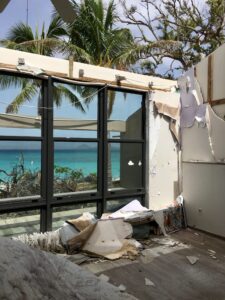
The NPS sent notice on November 30, 2023 of its plans to commence environmental clean up of Caneel Bay:
“ST. JOHN, U.S. Virgin Islands—The National Park Service (NPS) today announced that work to remove asbestos-containing material (ACM) at the Caneel Bay Resort site (site) within the Virgin Islands National Park will begin in early 2024.
This first phase of environmental cleanup at Caneel Bay will focus on removing asbestos-containing debris from 2017 Hurricanes Irma and Maria. On-site work will be conducted pursuant to NPS’s delegated authority under the Comprehensive Environmental Response, Compensation, and Liability Act (CERCLA). “
“After much planning and evaluation, we are pleased to begin environmental cleanup at Caneel Bay,” said Penelope Del Bene, acting superintendent, Virgin Islands National Park. “We look forward to contributing to a safer, healthier environment for our local community.”
Plans for ACM removal work resulted from the park’s 2021 Engineering Evaluation/Cost Analysis (EE/CA) Report and 2022 EE/CA Report Addendum, which documented releases of hazardous substances at the site. That report and others can be found here ParkPlanning – Public Involvement for the Engineering Evaluation/Cost Analysis (EE/CA) Site Assessment at Caneel Bay Resort (nps.gov)
Safety will be NPS’s top priority throughout the removal work. Contractors on the project will have the proper accreditations to safely handle, pack and transport ACM. NPS has also hired an independent company to monitor the ACM removal actions and conduct perimeter air monitoring to ensure asbestos fibers are not released into the environment. Work areas will be closed, except to qualified individuals. On-site work is expected to last three to four weeks. Over the course of the project, a total of six 20-foot-long cargo containers will be brought into the site, loaded with appropriately bagged and labeled ACM, and removed from the island as each container is filled. Containers of ACM will be transported from St. John to St. Thomas using a local barge service. ACM removed from the site will be disposed of in a permitted landfill in the continental United States, All project activity will be conducted in accordance with federal law and industry standards. During the work period, visitors may notice increased equipment noise. Minimal traffic impacts are expected.
Anticipated future removal actions under CERCLA include the removal of contaminated soil in the Site’s landscaping, maintenance and engineering area, as well as the removal of soil and waste from the landfill near Honeymoon Beach.
Current information about the NPS environmental cleanup efforts at Caneel Bay will be available at https://www.nps.gov/viis/caneelbay.htm.
The Park has said it plans to pursue a national register designation for the property regardless of what happens with the ownership and management of the resort. Caneel’s land is home to the remnants of one of the largest Taino villages on the island. Of the 128 buildings, sites, and structures at the resort, 109 have been found by the NPS to be contributing to the eligibility of Caneel Bay as a historic district due to their importance to pre-Columbian, colonial-era and post-transfer history.
Part III of this article will focus on the future of Caneel Bay


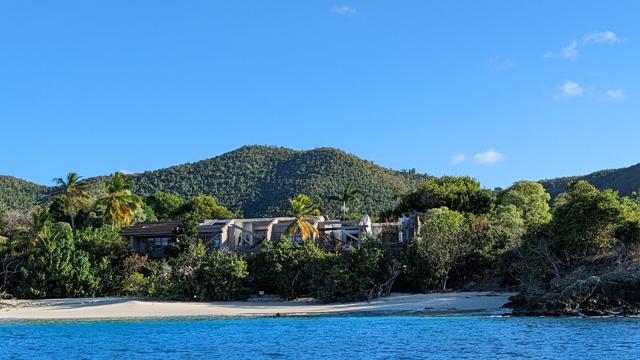
Nice Job Elise DuPont! No doubt a lot of work gathering your report. Looking forward to next iteration.
What is the marina that CBIA claims to own?
I think it is the dock that the ferry and other boats used next to Caneel Bay beach.
The claim on all land and improvements by EHI seems preposterous…. to the point that it seems they would undoubtedly be laughed out of court in any trial on the merits.
Really good write up. Lots of look up work already and nicely compiled to read. Facts are a forward motion. Thank you.
The “Marína” is located in Cruz Bay Creek, next to the NPS Visitor Center.
Thanks for the clarification Rafe. I know that Gary Engle owns the fuel dock by the VINP Visitor’s Center, but cannot think how that might affect visiting guests to Caneel Bay as Engle claimed in his letter to the DOI. Anybody can fuel there and it it’s just a fuel dock correct?
IMAGINE HUNDREDS OF CONCRETE TRUCKS TRAVERSING THE NORTH SHORE ROAD INSIDE THE NATIONAL PARK TO BUILD A NEW HOTEL AT CANEEL BAY FOR MONTHS, BUT PROBABLY YEARS. AND THAT’S AFTER THEY CREEP THROUGH CRUZ BAY ON ROADS BUILIT FOR DONKEYS AND GOATS.
Praying for preservation of this beautiful place. I would rather see clean up but not major construction.
Great article. The entire RUE seems so complex. I hope a hotel/resort just like Caneel is able to operate here. I think that is the only way this gorgeous area stays pristine. I think the Taino village is so interesting and hope the new park museum up on the hill has information and artifacts from here. Thanks for the education.
It is pretty clear to me that RUE Section 8 did not contemplate an exchange of the improvements for remuneration, but instead, as the US Attorney argued, was intended to cover transfer as a gift (i.e., without remuneration). If remuneration had been contemplated/intended, there would be discussion of an exchange for some fair market value of those improvements. It does not even discuss that. It’s pretty clear that Section 8 was intended to basically force the National Park system to accept as a gift the improvements if/when they were offered before the expiration of the RUE, or else forfeit the land on which the improvements rest to allow the owner of the improvements to sell the resort altogether — an outcome that was almost certain to never happen.
Of course the NPS would have accepted the transfer as a gift. I think the judge in this case will side with the Government. Any reading that suggests you could basically attempt to sell the improvements to the Government 6 months before the end of the RUE, and if they did not accept the terms of the sale you got the land (when the improvements would automatically have reverted to them 6 months later) is beyond the pale. And the judge certainly knows it.
The Retained Use Estate (RUE) only provided for the use and operation of the “Improvements” on the “Premises”. I could not find any document showing that EHI or CBIA actually have any conveyance to the “Improvements”. These structures were kept by Caneel Bay, Inc with a Deed transferring title to Jackson Hole Preserve on Sept 30, 2023. There is much confusion with this very important point. CBIA only had the right to use and operate guest facilities on the “Premises”. The RUE does not give any ownership to any structures “Improvements”. Furthermore, Section 8 is only for the termination of this RUE which is solely an exclusive right to occupy and operate guest facilities.
Thanks Elise for the research and very cogent explanation of these complex issues. Looking forward to next article.
Thank you. Brilliant explanation. Look forward to next article.